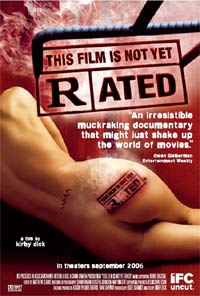Documentary Forces MPAA To Make Changes

After years of complaining, bitching, and whining from filmmakers, movie fans, and parents alike, the MPAA is finally making changes. They’re just not very big ones.
Variety reports that the MPAA and National Assn. of Theater Owners are launching a campaign to “demystify” the ratings system. Included will be another admonishment to parents to keep their kids away from R-Rated movies, and an outreach and education. Except no one is confused by the rating system, they know what it means. Parents who take their kids to R-rated movies know what they’re taking their kids too, they’re just bad parents and don’t really care. People are stupid, they’re just lazy and irresponsible.
Demystification isn’t what’s needed, changes in how they give movies ratings is. Luckily, there will be a little of that too. Along with the stuff they’re doing just for show, the MPAA plans to change their appeal process. For the first time ever, filmmakers will be allowed to cite other films as examples for the sort of rating they’re seeking. You’d think that would have been a given all along. Well at least that’s progress.
Did the documentary This Film Is Not Yet Rated had anything to do with it? Released in 2006, the documentary was a vicious expose of the MPAA’s ratings process. While it never made a big splash with the public, it was a hot topic around Hollywood circles. The MPAA was rumored to be rather displeased with the movie’s existence. MPAA head Dan Glickman admits that it was part of their motivation for changing things up a bit. He says, “The documentary made it clear that we probably haven't done as much as we can to explain how it all works.”
So here’s a breakdown of the MPAA’s changes, as reported by Variety.
1. A filmmaker who appeals a rating can reference similar scenes in other movies, although the appeals board still will focus heavily on context.
2. CARA (Classification and Ratings Administration operated by the MPAA) will formalize its rule that a member of the ratings board doesn't stay on the board after his or her children are grown.
Your Daily Blend of Entertainment News
3. CARA also will formalize its educational training system for raters.
4. When the CARA rules are implemented later this year, the MPAA and NATO will designate additional members to the appeals board who don't come from the MPAA or NATO fold. (Indie filmmakers might be one possibility.)
5. NATO and MPAA will occasionally be able to designate additional observers from different backgrounds to the appeals board.
6. For the first time, CARA will post the ratings rules on the MPAA Web site, describing the standards for each rating. The ratings and appeal processes also will be described in detail, along with a link to paperwork needed to submit a film for a rating.
7. Most members of the ratings board will remain anonymous, although CARA will describe the demographic make-up of the board, which is composed of parents. The names of the three senior raters have always been public; now, they will be posted online.
I’ve always been a big supporter of having a ratings system, but the process the MPAA uses to determine its ratings is convoluted and completely biased. Any system in which extreme violence gets a pass while simple depictions of the naked human body warrant an NC-17 needs work. The above does nothing to address any of that, instead it addresses some of the more minor problems with their process and how they communicate with the public. This is all just show, but at least it’s something.

